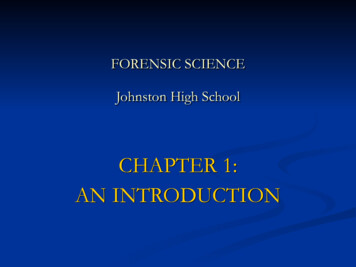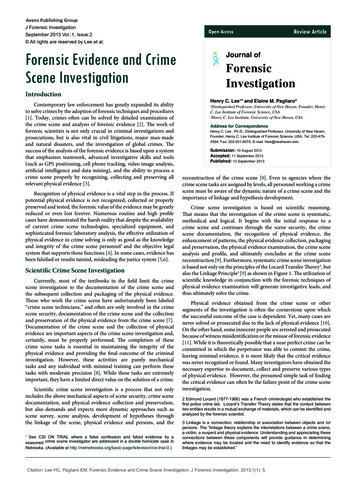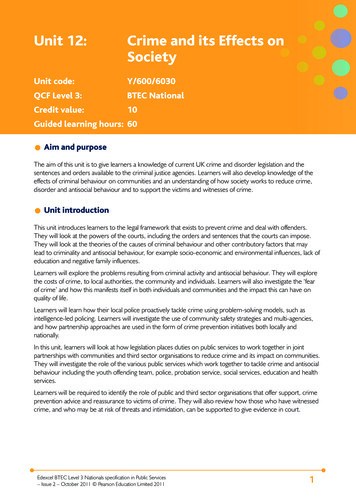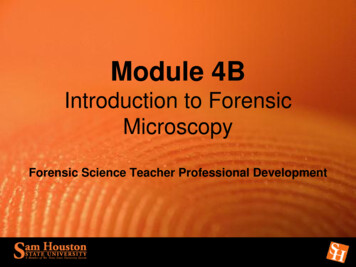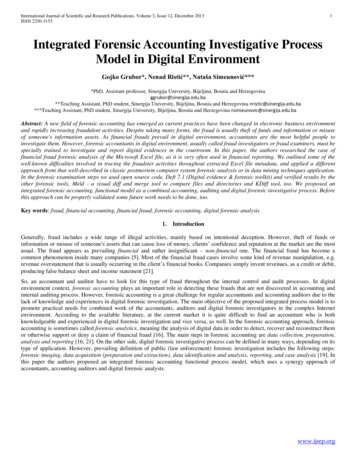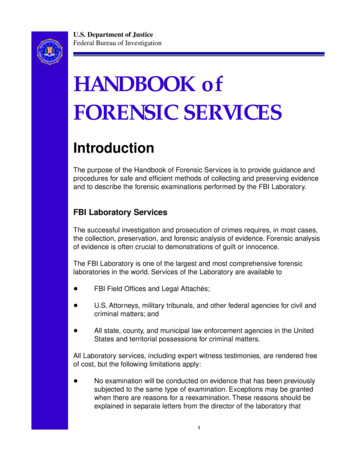
Transcription
U.S. Department of JusticeFederal Bureau of InvestigationHANDBOOK ofFORENSIC SERVICESIntroductionThe purpose of the Handbook of Forensic Services is to provide guidance andprocedures for safe and efficient methods of collecting and preserving evidenceand to describe the forensic examinations performed by the FBI Laboratory.FBI Laboratory ServicesThe successful investigation and prosecution of crimes requires, in most cases,the collection, preservation, and forensic analysis of evidence. Forensic analysisof evidence is often crucial to demonstrations of guilt or innocence.The FBI Laboratory is one of the largest and most comprehensive forensiclaboratories in the world. Services of the Laboratory are available to!FBI Field Offices and Legal Attachés;!U.S. Attorneys, military tribunals, and other federal agencies for civil andcriminal matters; and!All state, county, and municipal law enforcement agencies in the UnitedStates and territorial possessions for criminal matters.All Laboratory services, including expert witness testimonies, are rendered freeof cost, but the following limitations apply:!No examination will be conducted on evidence that has been previouslysubjected to the same type of examination. Exceptions may be grantedwhen there are reasons for a reexamination. These reasons should beexplained in separate letters from the director of the laboratory thatHANDBOOK OF FORENSIC SERVICES, 199911
Introductionconducted the original examination, the prosecuting attorney, and theinvestigating agency.!No request for an examination will be accepted from laboratories havingthe capability of conducting the examination. Exceptions may be madeupon approval of the FBI Laboratory's Assistant Director or his designee.!No testimony will be furnished if testimony on the same subject and in thesame case is provided for the prosecution by another expert.!No request for an examination will be accepted from a nonfederal lawenforcement agency in civil matters.Violent Crime Versus Property CrimeThe FBI Laboratory accepts evidence related to all crimes under investigation byFBI Field Offices. The FBI Laboratory accepts only evidence related to violentcrime investigations from state and local law enforcement agencies. TheLaboratory does not routinely accept evidence in cases involving property crimesfrom state and local law enforcement agencies unless there was personal injuryor intent to cause personal injury. These guidelines help to ensure that the FBILaboratory continues to provide timely forensic assistance to law enforcementagencies investigating crimes of violence or threatened violence. Additionalrestrictions may be imposed on case acceptance to achieve this goal.At the discretion of the FBI Laboratory's Assistant Director or his designee, theLaboratory may accept evidence from property crime cases. Such exceptions willbe considered on a case-by-case basis and should not be regarded as setting aprecedent for future case acceptance. All accepted cases will be afforded the fullrange of forensic services provided by the FBI Laboratory.The following are examples of property crimes that are not routinely accepted forexaminations:!Arson of unoccupied residential and commercial buildings and property;!Explosive incidents and hoaxes targeting unoccupied residential andcommercial buildings and property;!Vandalism and malicious mischief directed toward residential orcommercial buildings and property;HANDBOOK OF FORENSIC SERVICES, 19992
Introduction!Nonfatal traffic accidents involving speedometer and headlightexaminations except in cases involving law enforcement and governmentofficials;!Hit-and-run automobile accidents not involving personal injury;!Auto theft except auto theft rings or carjackings;!Breaking and entering;!Burglary;!Minor theft (under 100,000); and!Minor fraud (under 100,000).Back to the topHANDBOOK OF FORENSIC SERVICES, 19993
U.S. Department of JusticeFederal Bureau of InvestigationHANDBOOK of FORENSIC SERVICESEvidence SubmissionRequesting Evidence ExaminationsFor guidelines for how to package and ship evidence, see Packaging andShipping Evidence.All requests for evidence examinations should be in writing, addressed to the FBILaboratory Evidence Control Center, and contain the following information:!The submitting contact person's name, agency, address, and telephonenumber;HANDBOOK OF FORENSIC SERVICES, 199944
Evidence Submission!Previous case identification numbers, evidence submissions, andcommunications relating to the case;!Description of the nature and the basic facts concerning the case as theypertain to the Laboratory examinations;!The name or names of and descriptive data about the individual orindividuals involved (subject, suspect, victim, or a combination of thosecategories) and the agency-assigned case identification number; and!A list of the evidence being submitted herewith (enclosed) or underseparate cover."Herewith is limited to small items of evidence that are notendangered by transmitting in an envelope. Write on the envelopebefore placing evidence inside to avoid damaging or altering theevidence. The written communication should state: Submittedherewith are the following items of evidence."Separate cover is used to ship numerous or bulky items of evidenceor both. Include a copy of the communication requesting theexaminations. The written communication should state: Submittedunder separate cover by (list the method of shipment) are thefollowing items of evidence.!State what types of examinations are requested.!State where the evidence should be returned and where the Laboratoryreport should be sent.!Attach a statement as to whether the evidence was examined by anotherexpert in the same field, whether there is local controversy, or whetherother law enforcement agencies have an interest in the case.HANDBOOK OF FORENSIC SERVICES, 19995
Evidence Submission!State the need and reason or reasons for an expeditious examination. Donot request an expeditious examination routinely.!Submit a separate communication for multiple cases.Packaging and Shipping Evidence1. Prior to packaging and shipping evidence, call the pertinent unit of theLaboratory for specific instructions.2. Take precautions to preserve the evidence.3. When requesting latent print examinations, place nonporous evidence inindividual protective coverings such as thick transparent envelopes or suspend ina container so that there is minimal surface contact. Place porous evidence inindividual protective coverings such as paper envelopes. Stabilize the evidence toavoid movement or friction during shipment.4. Wrap and seal each item ofevidence separately to avoidcontamination.5. Place the evidence in a clean, dry,and previously unused inner container.6. Seal the inner container with tamper-evident or filament tape.7. Affix EVIDENCE and appropriate BIOHAZARD orHAZARDOUS MATERIALS labels to the inner container. To viewother hazardous materials labels, click here.HANDBOOK OF FORENSIC SERVICES, 19996
Evidence Submission8. If any of the evidence needs to beexamined for latent prints, labelLATENT on the inner container.9. Affix the evidence examinationrequest and all case informationbetween the inner and outercontainers.10. Place the sealed inner container ina clean, dry, and previously unusedouter container with clean packingmaterials. Do not use looseStyrofoamJ.11. Completely seal the outer container so that opening of the container wouldbe evident.12. Label the outer container with appropriate BIOHAZARD or HAZARDOUSMATERIALS labels.HANDBOOK OF FORENSIC SERVICES, 19997
Evidence Submission13. Address the outer container as follows:FBI LABORATORYATTENTION: EVIDENCE CONTROL CENTER935 PENNSYLVANIA AVENUE NWWASHINGTON DC 20535-000114. Ship evidence via U.S. PostalService Registered Mail, United ParcelService, or Federal Express. Recordthe method of shipment and thetracking number or numbers on thechain-of-custody form.15. Rendered-safe explosive devicesmust be shipped via United ParcelService.16. Live ammunition must be shipped via Federal Express. The followingguidelines must be followed to comply with U.S. Department of Transportationregulations:!Live ammunition must be packaged and shipped separately from firearms.!Pack ammunition in a cardboard container.!Label invoices FEDERAL EXPRESS.!The shipper's certification for restricted articles must be included.!The outside of the container must be labeled ORM-D AIR, CARTRIDGESSMALL ARMS.!The shipping papers must also include the weight in grams.HANDBOOK OF FORENSIC SERVICES, 19998
Evidence Submission17. The Interstate Shipment of Etiologic Agents (42 CFR Part 72) providespackaging and labeling requirements for etiologic agents (viable microorganismsor toxins that cause or may cause human disease) shipped in interstate traffic.For additional information, contact the Centers for Disease Control andPrevention in Atlanta, Georgia, at (404) 633-5313 or visit their Web site atwww.cdc.gov/od/ohs/biosfty/shipregs.htmPackage and label etiologic agents in volumesof less than 50 mL in glass tubes sealed withwaterproof tape as shown in the drawings tothe right and below.HANDBOOK OF FORENSIC SERVICES, 19999
Evidence SubmissionPlace each tube containing a cultureinside a capped container packedwith absorbent materials. Packagethis primary container within asecondary capped container that islabeled with the specimen record(CDC 3.203). Surround thesecondary container with dry iceand seal it within a capped shippingcontainer marked with thedestination address and theappropriate infectious substance oretiological agent label.Affix this regulation label to allshipments of etiologic agents.Back to the topHANDBOOK OF FORENSIC SERVICES, 199910
U.S. Department of JusticeFederal Bureau of InvestigationHazardous Materials LabelsHANDBOOK OF FORENSIC SERVICES, 199911
Hazardous Materials LabelsHANDBOOK OF FORENSIC SERVICES, 199912
Hazardous Materials Labels(Source: U.S. Department of Transportation at www.dot.gov)Back to the topBack to Evidence Submissions sectionHANDBOOK OF FORENSIC SERVICES, 199913
U.S. Department of JusticeFederal Bureau of InvestigationHANDBOOK of FORENSIC SERVICESEvidence ExaminationsUse the following links for examinations guidelines:Latent tographic ImagesPolygraphsPolymersQuestioned DocumentsRacketeering RecordsRopesSafe InsulationSerial NumbersShoeprintsSoilTire esAnthropologyArsonAudioBank Security DyesBuilding MaterialsComputersControlled SubstancesCordsDNAElectronic DevicesElemental AnalysisExplosivesExplosives ResidueFBI Disaster SquadFirearmsFibersGlassHairsInksHANDBOOK OF FORENSIC SERVICES, 19991414
U.S. Department of JusticeFederal Bureau of InvestigationAbrasives ExaminationsExaminations can determine what type of abrasive material was used tosabotage engines or machinery.Submitting Abrasives EvidenceQuestions concerning abrasives evidence should be directed to 202-324-4344.Follow the Evidence Submission directions including Requesting EvidenceExaminations and Packaging and Shipping Evidence.!Employ personnel familiar with engine and machinery operations andmechanics to recover abrasives.!Abrasives settle in oil and fuel. Submit the oil and fuel from the enginesump and/or filters.!Abrasives embed in bearings and other parts. Submit the bearings andother parts.!Submit abrasives in heat-sealed or resealable plastic bags or paint cans.Avoid using paper or glass containers.HANDBOOK OF FORENSIC SERVICES, 199915
U.S. Department of JusticeFederal Bureau of InvestigationAnthropology and OdontologyExaminationsAnthropological examinations can determine whether skeletal remains arehuman or animal. Race, sex, approximate height and stature, and approximateage at death can be determined from human skeletal remains.Personal identifications can be made by comparing teeth with dental records andX-rays.Submitting Anthropology andOdontology EvidenceQuestions concerning anthropology andodontology evidence should be directed to202-324-4344. Follow the EvidenceSubmission directions includingRequesting Evidence Examinations andPackaging and Shipping Evidence.!Clean and air dry bones and teeth.Pack in paper bags.!Collect insect samples found on theremains. Submit insects in leakproofcontainers such as film canisters orplastic pill bottles.!Submit medical and dental records, ifpossible.HANDBOOK OF FORENSIC SERVICES, 1999Recovered human remains comparedwith a plaster cast.16
U.S. Department of JusticeFederal Bureau of InvestigationArson ExaminationsArson examinations can determine the presence of accelerants introduced to afire scene. Examinations of debris recovered from scenes can identify gasoline,fuel oils, and speciality solvents. Examinations generally cannot identify specificbrands.Search for the following at questioned arson scenes: candles, cigarettes,matchbooks, Molotov cocktails, fused chemical masses, or any electronic ormechanical devices that may have been used to assist the arsonist. Also searchfor cloth or paper burn trails, burn trails on carpeted or hardwood floors, and theremoval of personal property or commercial inventory.Submitting Arson EvidenceQuestions concerning arson evidence should be directed to 202-324-4318.Follow the Evidence Submission directions including Requesting EvidenceExaminations and Packaging and Shipping Evidence.!Flammable liquids are volatile and easily lost through evaporation.Preserve evidence in airtight containers such as metal cans, glass jars, orheat-sealed or resealable plastic bags. Do not fill the containers to the top.Pack to prevent breakage.HANDBOOK OF FORENSIC SERVICES, 199917
U.S. Department of JusticeFederal Bureau of InvestigationAudio ExaminationsAuthenticityAuthenticity examinations are conducted to determine whether audio recordingsare original, continuous, unaltered, and consistent with the stated operation ofthe tape recorder.Audio analog tape recordings.EnhancementEnhancement examinations are conducted to selectively reduce interfering noiseon audio recordings to improve the intelligibility and the understanding of therecordings.Voice ComparisonsHANDBOOK OF FORENSIC SERVICES, 199918
Audio ExaminationsSignal AnalysisSignal analysis examinations are conducted to identify, compare, and interpretsignals such as gunshots and telephone touch tones.Damaged Media RepairAudio recordings can be repaired, restored, or retrieved for playback andexamination, if damage is not too extensive.Submitting Audio EvidenceQuestions concerning evidenceshould be directed to 703-632-6191or 703-632-6222. Follow theEvidence Submission directionsincluding Requesting EvidenceExaminations and Packaging andShipping Evidence.!Submit original audiorecordings.!Identify known and questionedvoice samples.!Label the outer container FRAGILE, SENSITIVE ELECTRONICEQUIPMENT or FRAGILE, SENSITIVE AUDIO/VIDEO MEDIA and KEEPAWAY FROM MAGNETS OR MAGNETIC FIELDS.!Address the outer container as follows:Audio formats.FEDERAL BUREAU OF INVESTIGATIONENGINEERING RESEARCH FACILITYATTENTION: FORENSIC PROGRAMBUILDING 27958AQUANTICO VA 22135Back to the topHANDBOOK OF FORENSIC SERVICES, 199919
U.S. Department of JusticeFederal Bureau of InvestigationBank Security Dyes ExaminationsSpecific dyes and chemicals used in bank security devices can be identified.Items such as clothing and money can be analyzed for the presence of thesedyes and chemicals.Submitting Bank Security Dyes EvidenceQuestions concerning bank security dyes evidence should be directed to202-324-4318. Follow the Evidence Submission directions includingRequesting Evidence Examinations and Packaging and Shipping Evidence.!Do not submit evidence without visible stains.!Do not submit large stained evidence. Cut a small sample of the stainedarea and submit in a heat-sealed or resealable plastic bag. Collect anunstained control sample, package separately, and submit it with the dyestained evidence.!Transfer questioned stains by rubbing with a clean (dry or wet withalcohol) cotton swab. Use an unstained swab as a control. Air dry theswab and pack in a heat-sealed or resealable plastic bag.HANDBOOK OF FORENSIC SERVICES, 199920
U.S. Department of JusticeFederal Bureau of InvestigationBuilding Materials ExaminationsExaminations can compare building materials such as brick, mortar, plaster,stucco, cement, and concrete.Submitting Building Materials EvidenceQuestions concerning building materials evidence should be directed to202-324-4344. Follow the Evidence Submission directions includingRequesting Evidence Examinations and Packaging and Shipping Evidence.!When building materials are penetrated or damaged, debris can adhere topersons, clothing, tools, bags, and loot and can transfer to vehicles. Ifpossible, submit the evidence to the Laboratory for examiners to removethe debris. Package each item of evidence in separate paper bags. Do notprocess tools for latent prints.!Collect known samples from the penetrated or damaged areas.!Submit known and questioned debris in separate leakproof containerssuch as film canisters or plastic pill bottles. Avoid using paper or glasscontainers. Pack to keep lumps intact.HANDBOOK OF FORENSIC SERVICES, 199921
U.S. Department of JusticeFederal Bureau of InvestigationComputer ExaminationsContentExaminations can determine what type of data files are in a computer.ComparisonExaminations can compare data files to known documents and data files.TransactionExaminations can determine the time and sequence that data files were created.ExtractionData files can be extracted from the computer.Deleted Data FilesDeleted data files can be recovered from the computer.Format ConversionData files can be converted from one format to another.Keyword SearchingData files can be searched for a word or phrase and all occurrences recorded.HANDBOOK OF FORENSIC SERVICES, 199922
Computer ExaminationsPasswordsPasswords can be recovered and decrypted.Limited Source CodeSource code can be analyzed and compared.Storage MediaStorage media used with stand-alone word processors (typewriters) can beexamined.Requesting a Search or Field ExaminationSubmit requests for a search or field examination at least one week in advance.Obtain as much of the following information as possible prior to submitting arequest.!Determine the type of computers and operating systems.!If applicable, determine the type of network software, the location of thenetwork servers, and the number of computers on the network.!Determine whether encryption and/or password protection is used.!Specify whether a seizure of computers and media or an on-siteexamination is required.Submitting Computer EvidenceQuestions concerning computer evidence should be directed to 202-324-9307.Follow the Evidence Submission directions including Requesting EvidenceExaminations and Packaging and Shipping Evidence.!For most examinations, submit only the central processing units and theinternal and external storage media.HANDBOOK OF FORENSIC SERVICES, 199923
Computer Examinations!Use a sturdy cardboard container when shipping computer components. Ifpossible, use the original packing case with the fitted padding. Use large,plastic bubble wrap or foam rubber pads as packing. Do not use looseStyrofoamJ because it lodges inside computers and/or components andcreates static charges that can cause data loss or damage to circuitboards. Seal the container with a strong packing tape.!Pack and ship central processing units in the upright position. Label theoutside container THIS END UP.!Disks, cartridges, tapes, and hard drives should be packed to avoidmovement during shipping.!Label the outer container FRAGILE, SENSITIVE ELECTRONICEQUIPMENT and KEEP AWAY FROM MAGNETS OR MAGNETICFIELDS.Back to the topHANDBOOK OF FORENSIC SERVICES, 199924
U.S. Department of JusticeFederal Bureau of InvestigationControlled SubstancesExaminationsControlled substances examinations can establish trace drug presence, identity,and quantity.Black tar heroin.Submitting Controlled Substances EvidenceQuestions concerning controlled substances evidence should be directed to202-324-4318. Follow the Evidence Submission directions includingRequesting Evidence Examinations and Packaging and Shipping Evidence.!Submit evidence in separate heat-sealed or resealable plastic bags.!Fold clothing to preserve trace evidence.!Do not submit used drug field test kits with evidence.HANDBOOK OF FORENSIC SERVICES, 199925
U.S. Department of JusticeFederal Bureau of InvestigationDNA ExaminationsDeoxyribonucleic acid (DNA) is analyzed in body fluids, stains, and otherbiological tissues recovered from evidence. The results of DNA analysis ofquestioned biological samples are compared with the results of DNA analysis ofknown samples. This analysis can associate victim(s) and/or suspect(s) witheach other or with a crime scene.Use the following links for guidelines for collecting and submitting DNAevidence:Blood ExaminationsCollecting Known SamplesBloodSalivaDocumenting, Collecting, Packaging, and Preserving DNA EvidenceSubmitting DNA EvidenceBlood on a PersonBlood on Surfaces or in Snow or WaterBloodstainsBlood Examination Request LetterSemen and Semen StainsSeminal Evidence From Sexual Assault Victim(s)Saliva and UrineHairTissues, Bones, and TeethHANDBOOK OF FORENSIC SERVICES, 199926
DNA ExaminationsBlood ExaminationsExaminations can determine the presence or absence of blood in stains.Examinations can also determine whether blood is human or nonhuman and candetermine the animal species. Blood examinations cannot determine the age orthe race of a person. Conventional serological techniques are not adequatelyinformative to positively identify a person as the source of a stain.Collecting Known SamplesBlood!Only qualified medical personnel should collect blood samples from aperson.!Collect at least two 5-mL tubes of blood in purple-top tubes with EDTA asan anticoagulant for DNA analysis. Collect drug or alcohol testing samplesin gray-top tubes with NaF (sodium fluoride).!Identify each tube with the date, time, subject’s name, location, collector’sname, case number, and evidence number.!Refrigerate, do not freeze blood samples. Use cold packs, not dry iceduring shipping.!Pack liquid blood tubes individually in StyrofoamJ or cylindrical tubecontainers with absorbent material surrounding the tubes.!Label the outer container KEEP IN A COOL DRY PLACE,REFRIGERATE UPON ARRIVAL, and BIOHAZARD. To view hazardousmaterials labels, click here.!Submit to the Laboratory as soon as possible.Saliva!Use clean cotton swabs to collect saliva samples. Rub the inside surfacesof the cheeks and gums thoroughly. Air dry the swabs and place in cleanpaper or an envelope with sealed corners. Do not use plastic containers.HANDBOOK OF FORENSIC SERVICES, 199927
DNA Examinations!Identify each sample with the date, time, subject’s name, location,collector’s name, case number, and evidence number.!Saliva samples do not need to be refrigerated.!Submit to the Laboratory as soon as possible.Documenting, Collecting, Packaging, andPreserving DNA EvidenceIf DNA evidence is not properly documented, collected, packaged, andpreserved, it will not meet the legal and scientific requirements for admissibility ina court of law.!If DNA evidence is not properly documented, its origin can be questioned.!If it is not properly collected, biological activity can be lost.!If it is not properly packaged, contamination can occur.!If it is not properly preserved, decomposition and deterioration can occur.When DNA evidence is transferred by direct or secondary (indirect) means, itremains on surfaces by absorption or adherence. In general, liquid biologicalevidence is absorbed into surfaces, and solid biological evidence adheres tosurfaces. Collecting, packaging, and preserving DNA evidence depends on theliquid or solid state and the condition of the evidence.The more that evidence retains its original integrity until it reaches theLaboratory, the greater the possibility of conducting useful examinations. It maybe necessary to use a variety of techniques to collect suspected body fluidevidence.Submitting DNA EvidenceQuestions concerning DNA evidence should be directed to 202-324-5436 or202-324-4354. Follow the Evidence Submission directions includingRequesting Evidence Examinations and Packaging and Shipping Evidence.HANDBOOK OF FORENSIC SERVICES, 199928
DNA ExaminationsBlood on a Person!Absorb suspected liquid blood onto a clean cotton cloth or swab. Leave aportion of the cloth or swab unstained as a control. Air dry the cloth orswab and pack in clean paper or an envelope with sealed corners. Do notuse plastic containers.!Absorb suspected dried blood onto a clean cotton cloth or swabmoistened with distilled water. Leave a portion of the cloth or swabunstained as a control. Air dry the cloth or swab and pack in clean paperor an envelope with sealed corners. Do not use plastic containers.Blood on Surfaces or in Snow or Water!Absorb suspected liquid blood or blood clots onto a clean cotton clothor swab. Leave a portion of the cloth or swab unstained as a control. Airdry the cloth or swab and pack in clean paper or an envelope with sealedcorners. Do not use plastic containers.!Collect suspected blood in snow or water immediately to avoid furtherdilution. Eliminate as much snow as possible. Place in a clean airtightcontainer. Freeze the evidence and submit as soon as possible to theLaboratory.Bloodstains! Air dry suspected wet bloodstained garments. Wrap suspected driedbloodstained garments in clean paper. Do not place wet or driedgarments in plastic or airtight containers. Place all debris or residue fromthe garments in clean paper or an envelope with sealed corners.! Air dry small suspected wet bloodstained objects and submit the objectsto the Laboratory. Preserve bloodstain patterns. Avoid creating additionalstain patterns during drying and packaging. Pack to prevent stain removalby abrasive action or packaging materials during shipping. Pack in cleanpaper. Do not use plastic containers.! When possible, cut a large sample of suspected bloodstains fromimmovable objects with a clean sharp instrument. Collect an unstainedcontrol sample. Pack to prevent stain removal by abrasive action orpackaging materials during shipping. Pack in clean paper. Do not useplastic containers.HANDBOOK OF FORENSIC SERVICES, 199929
DNA Examinations!Absorb suspected dried bloodstains on immovable objects onto aclean cotton cloth or swab moistened with distilled water. Leave a portionof the cloth or swab unstained as a control. Air dry the cloth or swab andpack in clean paper or an envelope with sealed corners. Do not use plasticcontainers.Blood Examination Request LetterA blood examination request letter should contain the following information:!A brief statement of facts relating to the case.!Claims made by the suspect(s) regarding the source of the blood.!Whether animal blood is present.!Whether the stains were laundered or diluted with other body fluids.!Information regarding the victim(s)’ and suspect(s)’ health, such as AIDS,hepatitis, or tuberculosis.Semen and Semen Stains!Absorb suspected liquid semen onto a clean cotton cloth or swab. Leavea portion of the cloth or swab unstained as a control. Air dry the cloth orswab and pack in clean paper or an envelope with sealed corners. Do notuse plastic containers.!Submit small suspected dry semen-stained objects to the Laboratory.Pack to prevent stain removal by abrasive action or packaging materialsduring shipping. Pack in clean paper. Do not use plastic containers.!When possible, cut a large sample of suspected semen stains fromimmovable objects with a clean sharp instrument. Collect an unstainedcontrol sample. Pack to prevent stain removal by abrasive action orpackaging materials during shipping. Pack in clean paper. Do not useplastic containers.!Absorb suspected dried semen stains on immovable objects onto aclean cotton cloth or swab moistened with distilled water. Leave a portionof the cloth or swab unstained as a control. Air dry the swab or cloth andHANDBOOK OF FORENSIC SERVICES, 199930
DNA Examinationsplace in clean paper or an envelope with sealed corners. Do not useplastic containers.Seminal Evidence From Sexual Assault Victim(s)!Sexual assault victim(s) should be medically examined in a hospital or aphysician’s office using a standard sexual assault evidence kit to collectvaginal, oral, and anal evidence.!Refrigerate and submit the evidence as soon as possible to theLaboratory.Saliva and Urine!Absorb suspected liquid saliva or urine onto a clean cotton cloth orswab. Leave a portion of the cloth unstained as a control. Air dry the clothor swab and pack in clean paper or an envelope with sealed corners. Donot use plastic containers.!Submit suspected small, dry saliva- or urine-stained objects to theLaboratory. Pack to prevent stain removal by abrasive action or packagingmaterials during shipping. Pack in clean paper or an envelope with sealedcorners. Do not use plastic containers.!When possible, cut a large sample of suspected saliva or urine stainsfrom immovable objects with a clean sharp instrument. Collect anunstained control sample. Pack to prevent stain removal by abrasive actionor packaging materials during shipping. Pack in clean paper. Do not useplastic containers.!Pick up cigarette butts with gloved hands or clean forceps. Do not submitashes. Air dry and place the cigarette butts from the same location(ashtray) in clean paper or an envelope with sealed corners. Do not submitthe ashtray unless latent print examination is requested. Package theashtray separately. Do not use plastic containers.!Pick up chewing gum with gloved hands or clean forceps. Air dry andplace in clean paper or an envelope with sealed corners. Do not useplastic containers.!Pick up envelopes an
HANDBOOK OF FORENSIC SERVICES, 1999 1 U.S. Department of Justice Federal Bureau of Investigation Introduction The purpose of the Handbook of Forensic Services is to provide guidance and procedures for safe and efficient methods of collecting and preserving evidence and to describe the forens


